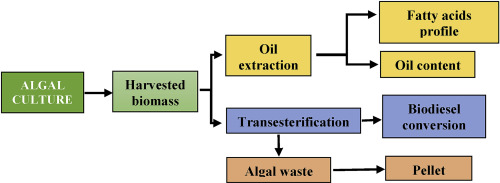当前位置:
X-MOL 学术
›
Renew. Energy
›
论文详情
Our official English website, www.x-mol.net, welcomes your
feedback! (Note: you will need to create a separate account there.)
Exploitation of Nannochloropsis gaditana biomass for biodiesel and pellet production
Renewable Energy ( IF 9.0 ) Pub Date : 2019-04-01 , DOI: 10.1016/j.renene.2018.10.075 A. Cancela , L. Pérez , A. Febrero , A. Sánchez , J.L. Salgueiro , L. Ortiz
Renewable Energy ( IF 9.0 ) Pub Date : 2019-04-01 , DOI: 10.1016/j.renene.2018.10.075 A. Cancela , L. Pérez , A. Febrero , A. Sánchez , J.L. Salgueiro , L. Ortiz

|
Abstract A comparison of different inorganic and organic flocculants at doses of 50, 100 and 200 mg/L was performed to achieve the maximum biomass harvesting of Nannochloropsis gaditana microalgae. The best results were reached by aluminium chloride with 90.9 ± 0.2% biomass recovered followed by copper sulphate with 70.8 ± 0.3% at the maximum doses used. If the behaviour is analysed after spending 24 h, all flocculants recovered more than 90% algal biomass. In the oil extraction process, a maximum of 29.25 ± 1.10% extracted oil was achieved by Soxhlet using methanol-chloroform 2:1 as solvent and applying previous disruption by microwave. 20.4% less oil was released when n-hexane was used. Ultrasound extraction assisted by microwave reached peak values of 22.60 ± 1.03%. Methyl esters of saturated fatty acids (C14:0, C16:0 and C18:0) were found as the major constituents, accounting for about 70% of the total content. Direct transesterification with previous incubation accomplished higher biodiesel conversions than without it. Finally, pellet manufacturing from algal wastes obtained after the transesterification reaction was studied. The results indicated that these pellet should be mixed with another type of biomass (e.g., miscanthus or eucalyptus) to be used as fuel in biomass boilers.
中文翻译:

用于生物柴油和颗粒生产的 Nannochloropsis gaditana 生物质的开发
摘要 对不同无机和有机絮凝剂在 50、100 和 200 mg/L 的剂量下进行比较,以实现 Nannochloropsis gaditana 微藻的最大生物量收获。最好的结果是氯化铝达到了 90.9 ± 0.2% 的生物量回收,然后是硫酸铜,在使用的最大剂量下达到了 70.8 ± 0.3%。如果在花费 24 小时后分析行为,则所有絮凝剂都恢复了 90% 以上的藻类生物量。在油提取过程中,使用甲醇-氯仿 2:1 作为溶剂,并通过微波进行先前的破坏,通过索氏提取的油最高可达 29.25 ± 1.10%。当使用正己烷时,释放的油减少了 20.4%。微波辅助的超声提取达到峰值 22.60 ± 1.03%。饱和脂肪酸甲酯(C14:0、C16:0 和 C18: 0)为主要成分,约占总含量的70%。与没有它相比,先前孵育的直接酯交换实现了更高的生物柴油转化率。最后,研究了从酯交换反应后获得的藻类废物制造颗粒。结果表明,这些颗粒应与另一种生物质(例如芒草或桉树)混合用作生物质锅炉的燃料。
更新日期:2019-04-01
中文翻译:

用于生物柴油和颗粒生产的 Nannochloropsis gaditana 生物质的开发
摘要 对不同无机和有机絮凝剂在 50、100 和 200 mg/L 的剂量下进行比较,以实现 Nannochloropsis gaditana 微藻的最大生物量收获。最好的结果是氯化铝达到了 90.9 ± 0.2% 的生物量回收,然后是硫酸铜,在使用的最大剂量下达到了 70.8 ± 0.3%。如果在花费 24 小时后分析行为,则所有絮凝剂都恢复了 90% 以上的藻类生物量。在油提取过程中,使用甲醇-氯仿 2:1 作为溶剂,并通过微波进行先前的破坏,通过索氏提取的油最高可达 29.25 ± 1.10%。当使用正己烷时,释放的油减少了 20.4%。微波辅助的超声提取达到峰值 22.60 ± 1.03%。饱和脂肪酸甲酯(C14:0、C16:0 和 C18: 0)为主要成分,约占总含量的70%。与没有它相比,先前孵育的直接酯交换实现了更高的生物柴油转化率。最后,研究了从酯交换反应后获得的藻类废物制造颗粒。结果表明,这些颗粒应与另一种生物质(例如芒草或桉树)混合用作生物质锅炉的燃料。











































 京公网安备 11010802027423号
京公网安备 11010802027423号